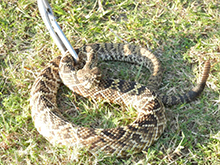Eastern Diamondback Rattlesnake (

Eastern Diamondback Rattlesnake
Venomous
- Length: 35″-84″
- Weight: 1-15 pounds
- Diet: Carnivorous, eating birds, rodents, and small animals.
- Breeding: July through August.
- Gestation: 180 Days.
- Reproduction: Live birth of 7-21 young late summer through early fall.
- Habitat: Dense wooded areas, palmetto flat woods, and urban areas.
- Legal Status: Common in North Carolina, and illegal to harm, capture, or remove from the wild in North Carolina.
- Other Names: North Carolina Rattlesnake, Diamond Rattlesnake, Yellow Rattlesnake, and Black Rattlesnake.
- Interesting Facts: The eastern diamondback rattlesnake is the largest venomous snake in North America with snakes ranging as long as 7-8 feet. It has the longest fangs of all other rattlesnake species.
The Eastern Diamondback Rattlesnake can on average grow between 35″ and 84″ long. Average weight of a Eastern Diamondback Rattlesnake can be between on average 1-15 lbs, with some large specimens reaching nearly 20 lbs. They are usually active between March through October, but depending on geographical location and warmer temperatures, can still be active on winter days. Eastern Diamondback Rattlesnakes give birth between August through late September to live young and can have as many as 21 young. They ares capable of living in the wild 12 years to as many as 20 years, and typically will den up in a animal burrow during winter. Typical food sources of the Eastern Diamondback Rattlesnakes can consist of small mammals, including squirrels, birds, amphibians, and even other snakes. Usually shedding its skin every year a new rattle segment will grow, or button on its rattle. The venom of the Eastern Diamondback Rattlesnake is used to immobilize prey, but can be fatal to people if a untreated bite occurs. Venom of a rattlesnake stops blood from clotting, and can destroy tissue and organs. If you happen to be struck, seek medical attention immediately. Most rattlesnake bites occur when trying to handle or harassing a snake. Eastern Diamondback Rattlesnakes can strike over 2/3 their body length.
